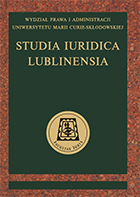Konfiskata czy sekwestr nieruchomości klasztornych w Królestwie Polskim w 1864 r.?
Confiscation or Sequestration of Monastic Properties in the Kingdom of Poland in 1864?
Author(s): Wacław UruszczakSubject(s): Christian Theology and Religion, Public Administration, Government/Political systems, 19th Century, Canon Law / Church Law
Published by: Wydawnictwo Naukowe Uniwersytetu Marii Curie-Sklodowskiej
Keywords: Kingdom of Poland (Congress Poland); the January Uprising of 1863; the Church in Poland in the 19th century; the dissolution of the monasteries; Tsar Alexander II’s ukase of October 27 November 8;
Summary/Abstract: After the fall of the January Uprising (1863/1864), the Tsarist government abolished the last elements of political and administrative autonomy of the Kingdom of Poland, transforming it into the Vistula Land. Insurgents and their families as well as the Catholic Church, as a major mainstay of Polishness, were most affected by the Tsarist repressions. One of the major points of these anti-Church repressions conducted by the Tsarist government was the dissolution and reorganization of monasteries carried out under the ukase issued by Tsar Alexander II on October 27/ November 8, 1864. The dissolution of the monastery entailed the occupation of the whole monastic property. The monastery church was turned over to the nearest parish administration as a parish or rectorial church. Land and other properties were transferred to the management of the State Treasury. In historical literature, the question of secularization of the properties which belonged to the abolished and closed monasteries in 1864 is neither clear-cut nor free from doubts. Was it really about taking over monastic goods by the State Treasury? In the article, the author proves that the Tsar’s ukase of 1864 did not claim the state-owned property towards the occupied monastic land. The land remained the property of the Church, staying under indefinite State Treasury management (the so-called sequestration). The question arises, however, as to which ecclesiastical legal person that property belonged to, since the current holder of property law, namely the monastery was disbanded. The answer to this question can be found in the Ukase which states that the property is under “diocesan sovereignty”, namely the bishop or archbishop relevant for the particular monastery’s location. It also remained in line with the regulations of canon law of the Catholic Church. The principle of canon law has been and still is that in case of the liquidation of an ecclesiastical moral (legal) person, its assets automatically, by virtue of law, become the property of the legal (directly superior) person. This principle was established by a canon 1501 of the Code of Canon Law of 1917, whose regulation was a repetition of the principles of the Corpus Juris Canonici which was used in the 19th century. Tsar of Russia and his officials were obliged to respect the norms of canon law of the Catholic Church in the Kingdom of Poland (Congress Poland) under the Concordat of August 3, 1847 concluded between Tsar Nicholas I and Pope Pius IX. In case of the liquidation of the monastery under the Ukase of 1864 with simultaneous taking over the monastic properties by the State management, they did not become no one’s property. Under canon law, this property was automatically transferred to the ecclesiastical, legal (directly superior) person.
Journal: Studia Iuridica Lublinensia
- Issue Year: 25/2016
- Issue No: 3
- Page Range: 933-944
- Page Count: 12
- Language: Polish

